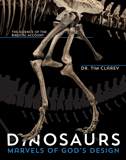
New Argentinian Dinosaur Fossil May Hold Dino-Bird Connection
National Geographic News: “New Birdlike Dinosaur Found in Argentina” A dinosaur unearthed in Argentina could be the latest evidence for a dino–bird connection, paleontologists report.
A team led by National Geographic explorer-in-residence Paul Sereno (a University of Chicago paleontologist) has found and analyzed the remains of an elephant-sized predatory dinosaur called Aerosteon riocoloradensis. The dinosaur was dated to 85 million years ago and reveals bones that suggest the dinosaur had air sacs, which seemingly would have pumped air into the terrible lizard’s lungs in much the same way as they function in birds.
The dinosaur was dated to 85 million years ago and reveals bones that suggest the dinosaur had air sacs.
The specific fossil components that tipped the scientists off to the air sacs were a wishbone, hip bone, and stomach ribs that were hollowed out, like those of birds. “This leaves little discussion that air sacs existed and that meat-eaters really do have lung structures that resemble birds,” Sereno explained.
The air sac structure allows birds to breathe more efficiently because their lungs don’t expand in the process of breathing. In dinosaurs, such structure may have helped increase their lung efficiency and balance the top-heavy weight of those who moved on two hind legs. Additionally, Reuters reports that the air sacs could have helped regulate the body temperature of dinosaurs.
In other words, the air sac design was appropriate for dinosaurs’ ambulatory and ventilation/temperature needs. So while National Geographic News reports that the discovery “cements the connection between dinosaur and avian evolution,” it really only suggests the idea that, like birds, dinosaurs may have possessed air sacs that suited their needs.
As usual, the evolutionary connection is based on the idea that homology is independent proof of evolution. In fact, as we’ve said many times in the past, homologous structures can also be interpreted (just as well) as evidence for a common designer who re-used designs when appropriate. Also, evolutionists frequently toss out homologues when they don’t fit into pre-existing evolutionary schemata, claiming “convergent evolution” instead.
Of course, all of this is also assuming the air sac discovery really is just that. Don’t forget that the air sac structures themselves were not fossilized, and thus the idea rests on the holes found in the various A. riocoloradensis bones.
In somewhat related news—which has stirred up controversy among evolutionists—the University of Tokyo’s Katsufumi Sato has claimed pterodactyls were too heavy to fly. Soto based the claim on wing-thrust data gathered from accelerometers attached to five bird species. However, we note that the Bible—in such places as Isaiah 14:29; 30:6—does reference “flying serpents” that were likely a now-extinct flying reptile, perhaps such as pterosaurs. As for whether Soto’s hypothesis is accepted or rejected by the rest of the paleontological community, only time will tell.
For more information:
Remember, if you see a news story that might merit some attention, let us know about it! (Note: if the story originates from the Associated Press, Fox News, MSNBC, the New York Times, or another major national media outlet, we will most likely have already heard about it.) And thanks to all of our readers who have submitted great news tips to us.
(Please note that links will take you directly to the source. Answers in Genesis is not responsible for content on the websites to which we refer. For more information, please see our Privacy Policy.)
Recommended Resources

Answers in Genesis is an apologetics ministry, dedicated to helping Christians defend their faith and proclaim the good news of Jesus Christ.
- Customer Service 800.778.3390
- © 2024 Answers in Genesis






